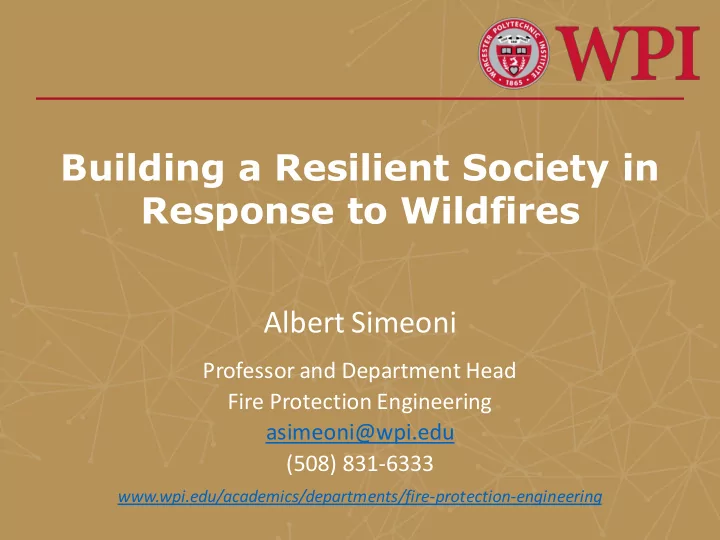

Building a Resilient Society in Response to Wildfires Albert Simeoni Professor and Department Head Fire Protection Engineering asimeoni@wpi.edu (508) 831-6333 www.wpi.edu/academics/departments/fire-protection-engineering
Building a Resilient Society in Response to Wildfires The Context Fire impact is growing because of: • Climate Change (including wet years) • Urban Sprawl / population growth (exposure, ignitions) • Structures and communities vulnerability to fires The Mercury News DNA India Different aspects to consider: the wildland fires, the spread mechanisms, and the structures
Building a Resilient Society in Response to Wildfires Wildland Fires and Related Issues • Multiple ignitions • Extreme fire behavior • Elevated rate of spread • Higher heat fluxes • Ember showers SWNS.com • Merging fires • Fire whirls • Safety • Smoke • Influence on evacuation High Country News
Building a Resilient Society in Response to Wildfires The Spread Mechanisms • Convective transfer / Flame contact • Radiative transfer • Firebrands • Can be vegetation-to-structure or structure-to-structure • Complex interaction between topography, wind, vegetation and structures • WUI and community geometry channeling wind, flames, and firebrands • Spread corridors exist through communities
Building a Resilient Society in Response to Wildfires The Structures • 38% of new home construction in Western US is in WUI areas • Enormous growth in the last 50 years in Greece (tourism, second homes, population concentration in the Mediterranean region) • Whole areas are wiped out • Fires often transition from wildland fires to urban / suburban fires • Ornamental vegetation can be left almost untouched Thomas fire – abc news Mati fire – Reuters
Building a Resilient Society in Response to Wildfires The Structures • Community design: • Fire can spread from structure to structure resulting in a large domino effect • Sometimes, the interaction between fire, burning vegetation and burning structures can be very complex • Design can be assessed / improved at different scales
Building a Resilient Society in Response to Wildfires Building resilience • Community design: • Fire spreads in heterogeneous ways • Design can be used to leverage this aspect for protection purposes North-Corsica fire Tubbs fire Mati fire
Building a Resilient Society in Response to Wildfires Building resilience • Public education: • Property maintenance • Evacuation
Building a Resilient Society in Response to Wildfires Building resilience • Training and Education: • Inspectors / enforcers • Architects / designers • Engineers • Researchers Cal fire Robert Nebolon Architects
Building a Resilient Society in Response to Wildfires Building resilience • First responders: • Safety • Evacuation • Decision support systems
Building a Resilient Society in Response to Wildfires Building resilience • Research: • Extreme fire behavior • Fire impact • Design solution at the wildland-urban interface • Codes and Standards • Decision support systems • Firefighter safety
Building a Resilient Society in Response to Wildfires The complexity of modeling Time Scales Space Scales Wind (O 2 ) Wind, T opography Heat transfer Combustion Reaction ( m) Fuel particule (mm to cm) V egetation species (20 cm to 20 m) Plot scale in field experiments (100 m) Fire scale (km) Atmospheric scale (100 km)
Building a Resilient Society in Response to Wildfires
Building a Resilient Society in Response to Wildfires
Building a Resilient Society in Response to Wildfires • Fuel consumption is a function of fire dynamics • Difficult to differentiate what was burned during the fire / after the fire
Building a Resilient Society in Response to Wildfires
Building a Resilient Society in Response to Wildfires
Building a Resilient Society in Response to Wildfires Experimental conditions − Wind − Wood material − Amount of firebrands − Size and material of firebrands − Wedge angle − Tilt angle − Sample gap Flaming ignition occurs after hole through sample Flaming occurs on back face of sample
Building a Resilient Society in Response to Wildfires Understanding the different scales Drag Forces in the forest Burning dynamics Heat Release Rate Temperature Distribution
Building a Resilient Society in Response to Wildfires Radiant Panel Experiment (absorption by vegetation) Lattice Boltzmann Method (Drag forces and convection)
Building a Resilient Society in Response to Wildfires
Building a Resilient Society in Response to Wildfires
Recommend
More recommend